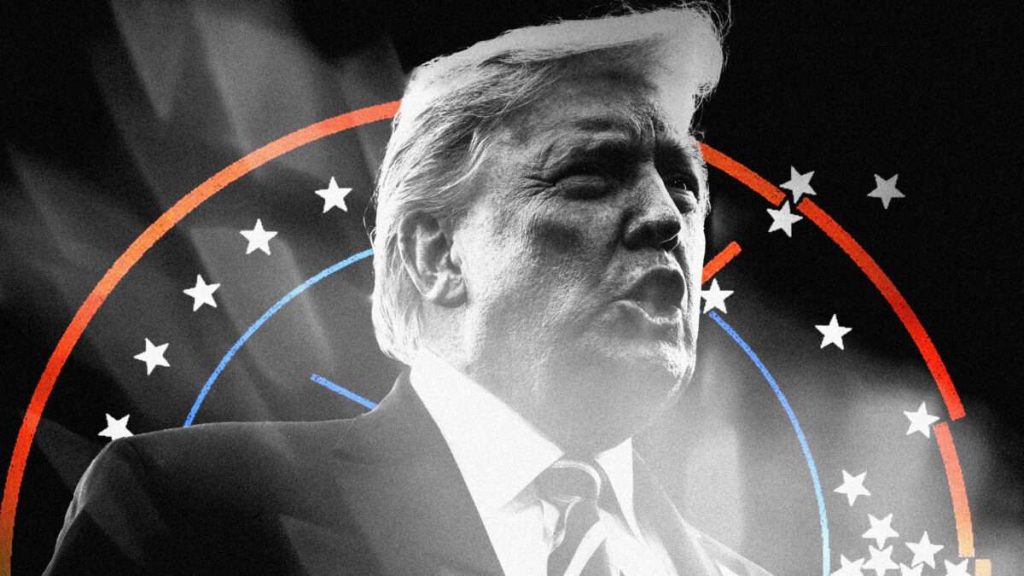When the Clock Broke: Con Men, Conspiracists, and How America Cracked Up in the Early 1990s, by John Ganz, Farrar, Straus and Giroux, 432 pages, $30
When the Clock Broke, by the progressive essayist John Ganz, is a solidly educational and entertaining work of political history. While Ganz winningly doesn’t bash you over the head page by page with the larger point he’s trying to make, the stories he chooses to tell about the early 1990s are meant to hit home how elements of American political, cultural, economic, and ideological life back then laid the groundwork for Donald Trump’s “Make America Great Again” (MAGA) movement today.
His title derives from an obscure 1992 speech by a figure most progressive readers have likely never heard of: the libertarian-movement founding father and gadfly Murray Rothbard, an economist who also explored political philosophy and history as he built a case for a totally stateless society.
Most libertarians’ amour-propre might be wounded seeing their movement fingered as having meaningfully paved the way for Trumpism. But in May, the management of the Libertarian Party, dominated by a caucus that sees itself in the Rothbardian tradition, invited former President Donald Trump to speak at their presidential nominating convention, where he tried to make the case that their votes rightfully belonged to him. Whether or not it makes philosophical sense, there is something to Ganz’s attempts to link anarcho-capitalist Rothbard with big-state caudillo Trump.
MAGA does at times seem to wear the mantle of smash-the-state anarchism in its rage against the modern progressive state, though Trump’s regime managed a state pretty much as big and intrusive as its predecessors’ (except for some tax and regulation reductions that were GOP orthodoxy long before Trump). And the Rothbardians’ state-hatred can make any punctiliousness about the institutions of democracy and peaceful change of power that Trump threatened seem besides the point: If the state is pure rapine and murder, who can get too upset about whether or not power is exchanged politely?
Since most of this book about the tumult of the early 1990s has nothing to do with Rothbard or libertarianism, readers may wonder why they are hearing quite so much about things like what that eccentric economist in Las Vegas thought about Woody Allen’s love life, or why his statement underlies the book’s title. Ganz’s choice here seems to imply that the clock-breaking Rothbard advocated actually happened.
What Rothbard called for—in a talk to the John Randolph Club, a mixed gathering of libertarians and reactionaries—was to “break the clock” of “social democracy…Great Society…welfare state…and New Deal.” That clock-breaking obviously did not happen. The best one can say for such a thesis is that Rothbard in the last few years of his life—after his “paleo” turn led him to reject most of the libertarian movement and ally himself instead with Pat Buchanan–style conservatives—began dreaming of a Trumpian-styled right-populist champion on the horizon, one who would aggressively and with no politesse punch left-liberalism in the metaphorical nose. But When Obscure Agitators Who Wanted To Break the Clock Sounded Political Notes That Trump Later Magnified and Succeeded With isn’t as catchy a title.
Rothbard and the paleos did accurately foresee something looming in American political culture that the libertarian comrades he left behind did not: that political success could be had by linking rhetorical anti-statism (about some things at least) with a gleefully rude appeal to white resentment.
More Trumpy than Rothbard were the other major characters in Ganz’s narrative. Certainly, Buchanan’s 1992 presidential campaign, detailed here at length, was a dry run for Trump, as were Buchanan’s later books obsessed with defending the white European character of America by putting the brakes on immigration—though Buchanan was more conventionally educated in politics and economics than Trump is.
Another obscure writer whose story Ganz tells, Samuel Francis, presaged Trump in an almost eerily on-the-nose manner. Francis’ columns in The Washington Times and Chronicles advocated an American right that was more open to bully-boy violence and even terror, more obsessed with closed borders, more furious at cultural elites, and more willing to use the government as a nationalist tool to prop up a white working-class constituency, reverse progressive cultural change, and tame “woke” corporations (long before that term was in use, of course).
Underlying Ganz’s story is a narrative also believed by his ideological enemies on the nationalist right: that Reagan-era deregulation, deindustrialization, tax cuts, loosening of trade restrictions, and union-busting annihilated any chance for America’s former middle classes to thrive, drove them insane, and led them to Trump.
But most evidence indicates that Trump voters are driven more by cultural insecurities and resentments than by economic ones. Besides, Ganz’s story of American economic life in its focus only on decline is misleading and overly pessimistic. His book gives the impression that from the early 1990s to Trump’s rise, an unrelenting economic disaster settled over the American working man. In fact, from 1992 to 2016 per capita gross domestic product more than doubled, as did median personal income; the median hourly wage nearly doubled; and while the homeownership rate declined, it did so by less than 1 percent (and was by 2023 nearly 2 percent above the 1992 rate). In that quarter century, more of the middle class disappeared into upper classes than tumbled into eternal penury, with the percentage of Americans in the lower middle class or poor shrinking by around 8 percent and the percentage in the upper middle class or rich going up by around 10 percent.
This is not to deny that there were individual voters who fell on the bad end of economic change or had other reasons to feel aggrieved. But it does blunt the idea that economic devastation explains Trump.
The bulk of Ganz’s book tells the early-1990s stories of Jesse Jackson, Rush Limbaugh, Ross Perot, Bill Clinton, Daryl Gates, Randy Weaver, and John Giotti, drawing more or less convincing or interesting parallels between their activities then and Trumpian modernity. The Jackson chapter, with its focus on Bill Clinton’s “Sister Souljah” moment, reminds us that in a pre-woke age even a liberal Democrat could sound tough on racial politics in a way that reads as MAGA now. The Limbaugh chapter highlights one clear aspect of Trump’s appeal, as the paladin defending middle Americans who feel disrespected and mocked by those who control their culture and government. (Trump, Ganz demonstrates, is a walking embodiment of early-’90s right-wing talk radio.) The Gates chapter reminds us that in an era of far more prevalent crime than the one Trump portrayed as “American carnage,” worries about street crime didn’t necessarily have a racial valence, as even many black citizens and leaders wanted tougher policing. (Not that this was the point Ganz was trying to make.)
The Perot chapter shows that many Americans (though not nearly an electoral majority) were already in the early 1990s hungry for a non-status-quo strongman and didn’t care exactly how that would play out in policy terms. And the Giotti chapter, at the book’s end, is intended to make the reader think of Trump as more organized crime figure than politician, wrapping up the narrative with a small frisson of fear about what might await America next year.
The 1990s are a fresh area for Ganz to make his writerly mark. But if you read Rick Perlstein’s work on the American right in the 1970s (an obvious influence on Ganz in both style and intent, though Ganz can’t quite pull off Perlstein’s effortlessly delightful readability), you’ll see there was nothing uniquely germinal in the ’90s for the Trump movement. It was a longer time coming.
Racial and ethnic resentment, revolutionary activity on the part of a tiny margin (with a larger audience of fascinated admirers), a conservative America that feels mocked and disrespected by an elite class, fear of clandestine government agencies, worries about the working class losing economic ground: They were not new in the Trump era, nor did they begin in the ’90s. They are persistent parts of the modern American experience.
While Ganz wants to blame free markets for destroying widespread American prosperity, as always, the path to consistently creating wealth (and eventually spreading it more evenly) lies in halting government practices that have slowed down wage growth and productivity, particularly barriers to practicing professions and creating businesses and building living spaces. As always, the most state-encrusted parts of the economy, such as health care and higher education, are the most sclerotic and expensive.
As Ganz makes clear, the fascist-adjacent philosophers that his villain Francis doted on, the likes of Georges Sorel and Vilfredo Pareto, tended to analyze all social issues and crises in terms of who has power and who they wield it against. This is the mindset that leads tribalists such as Francis to try to make the American right a more explicitly race-based operation, as well as one eager to use state power to crush its cultural enemies. In a multiracial, multiethnic republic—something that America will continue to be no matter how many immigration restrictions the right tries to impose—that’s bad for peace and prosperity.
Ganz launches his book with the political saga of David Duke, the former Ku Klux Klan leader who became a Louisiana state legislator from 1989 to 1992, a story that hits home how much the author centers racial conflict in the modern American story. Trump is certainly more circumspect on race issues than Duke. But to the extent that he and his epigones make politics more race-conscious, the worse things will get for America. The same goes for race-conscious Democrats.
Despite Rothbard’s embrace of right-wing populism in his declining years, the libertarian project he did so much to further for most of his career—the project of limiting and decentralizing power rather than frantically striving to use it against your perceived enemies—is all the more vital for civic peace and prosperity in the Trump and post-Trump eras.
The post It Didn’t Start With Trump appeared first on Reason.com.







